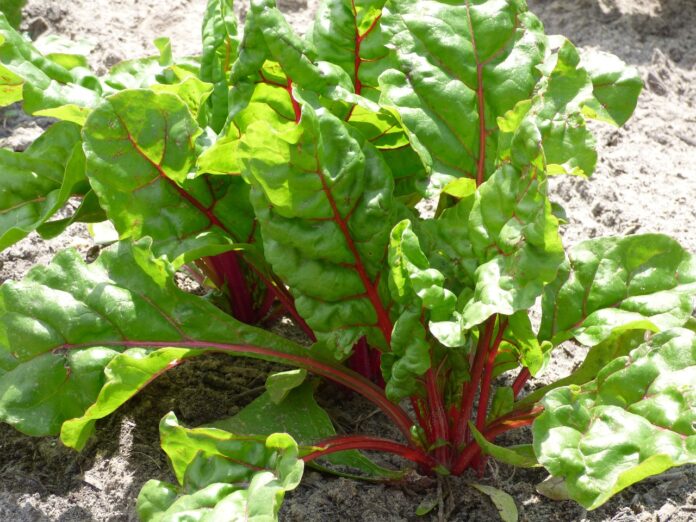Chard, also known as Swiss chard or simply chard, is a leafy green vegetable scientifically named Beta vulgaris subsp. cicla. It belongs to the same family as beets and spinach and is known for its nutrient-rich leaves and colorful, often vibrant stems. Chard is praised for its versatility in culinary use and impressive nutritional profile.
Interesting Facts About Chard:
- Chard belongs to the beet family: Chard is classified as Beta vulgaris, the same species as beets, but unlike beets, chard is grown for its edible leaves and stalks rather than its root. It is sometimes referred to as “leaf beet” due to this connection
- Different colors of chard: Chard is available in multiple color varieties. These colors are most apparent in the stalks, which can range from white, yellow, and red to purple. These colored varieties, often sold as “rainbow chard,” are visually striking and are popular in gardens and markets for their beauty as well as their nutrition
- Rich in fiber: With approximately 2.1 grams of dietary fiber per 100 grams, chard helps in digestion, promotes gut health, and can aid in lowering cholesterol. Fiber also helps in stabilizing blood sugar levels, which is beneficial for people with diabetes
- Swiss chard is a misnomer: The term “Swiss chard” has nothing to do with Switzerland directly. The name may have originated in reference to the Swiss botanist Gaspard Bauhin, who described the plant, or it might relate to its widespread use in Swiss cuisine, despite its Mediterranean origin
- Biennial plant: Chard is a biennial, meaning it takes two years to complete its life cycle. However, it is commonly grown as an annual for its tender leaves, and farmers often harvest multiple crops from the same plant throughout the season
- Chard as a “superfood”: Known for its dense nutrient profile, chard contains potent antioxidants like flavonoids and carotenoids. These nutrients may help fight oxidative stress, reduce inflammation, and promote cardiovascular health. Chard is often highlighted as part of a healthy, balanced diet
- Popular in Mediterranean cuisine: Chard has been a staple of Mediterranean diets for centuries. It is used in a variety of traditional dishes, such as the Swiss dish “capuns” (Swiss chard-stuffed dumplings). The Mediterranean diet is well-known for its emphasis on plant-based foods like leafy greens
- Chard leaves and stems are both edible: Unlike many other leafy vegetables, chard’s stems are also edible, though they require longer cooking. These stems come in a variety of colors, and their texture adds a distinct crunch when cooked properly. The stems are often discarded in other plants like spinach but are an integral part of chard
- Chard is a good source of lutein: Lutein, a type of antioxidant carotenoid found in chard, is especially beneficial for eye health. It can help protect the eyes from the damaging effects of light and may lower the risk of age-related macular degeneration (AMD)
- Chard is part of the “beet” family: As a relative of beets, chard shares the same family and some of the same characteristics. Both plants thrive in similar growing conditions, and both have edible, nutritious foliage. Unlike beets, however, chard is prized for its leafy greens rather than its root
- Can be grown in a variety of climates: Though chard prefers cool weather, it is quite adaptable and can be grown in both warm and cold climates. It has a long growing season, from early spring to late fall, depending on local temperatures. With regular watering, it can also be grown in hotter climates with moderate success
- High in magnesium: Magnesium is another essential nutrient present in chard, which supports muscle and nerve function, boosts immune system health, and aids in the synthesis of protein. Magnesium also plays a key role in keeping blood sugar levels stable
- Natural source of iron: As a plant-based source of iron, chard is particularly beneficial for individuals on vegetarian or vegan diets. Iron is essential for the production of hemoglobin, which carries oxygen in the blood. Consuming iron-rich foods like chard helps prevent anemia
- Popular as a food for athletes: Chard is often recommended to athletes due to its ability to replenish essential nutrients lost during intense physical activity. It provides a good combination of vitamins, minerals, and electrolytes that help with recovery, muscle health, and energy
- Long shelf life: Chard can stay fresh in the fridge for up to a week if stored properly. To maximize its shelf life, it should be wrapped in a damp paper towel and kept in a plastic bag to retain moisture, preventing it from wilting
